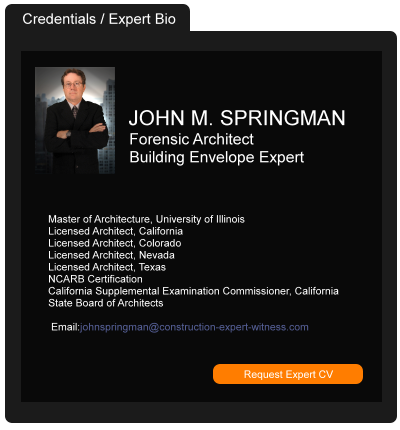Construction Professionals Could Face More Liability Exposure Following California Appellate Ruling
December 17, 2024 —
Jamison Rayfield & Brian Slome - Lewis BrisboisSan Diego/San Francisco, Calif. - The California Court of Appeal
recently reversed a summary judgment ruling in favor of a geotechnical engineering firm that had conducted a brief inspection of a residential construction project's footing trench for $360. The case arose when homeowner Cheryl Lynch experienced significant property damage after her home's foundation failed and the structure began subsiding into a slope. Lynch sued Peter & Associates for professional negligence and nuisance, despite having no direct contractual relationship with the firm, which had been hired by her contractor to perform the geotechnical inspection.
The court distinguished this case from Bily v. Arthur Young & Co. (1992) 3 Cal.4th 370, which had limited auditors' professional duty to third parties, noting that Bily dealt with purely economic damages, whereas Lynch involved physical property damage, making Bily's policy concerns about unlimited liability inapplicable. The court emphasized that construction professional negligence cases, particularly those involving residential property damage, warrant a different analysis than cases involving economic loss.
Reprinted courtesy of
Jamison Rayfield, Lewis Brisbois and
Brian Slome, Lewis Brisbois
Mr. Rayfield may be contacted at Jamison.Rayfield@lewisbrisbois.com
Mr. Slome may be contacted at Brian.Slome@lewisbrisbois.com
Read the court decisionRead the full story...Reprinted courtesy of
English v. RKK. . . The Rest of the Story
December 04, 2018 —
Christopher G. Hill - Construction Law MusingsBack in February, I discussed a case relating to indemnity and ambiguity. The opinion in that case, W.C. English, Inc. v. Rummel, Klepper & Kahl, LLP et al., allowed a breach of contract and indemnity claim to move forward despite the fact that conflicting term sheets between the plaintiff and defendant could have been read to violate Virginia law by requiring indemnity for English’s own negligence. In other words, the ambiguity worked in English’s favor (though that is not something to count on). The Court did not however address whether there was any negligence on English’s part and if there was, what was the contractual effect.
I’ll bet you were wondering what happened later in that case. Well, here’s the answer. In a subsequent opinion, the Court looked at the same ambiguous and conflicting term sheets between and among those defendants that were required to provide quality assurance services for the construction of a bridge in western Virginia. For the full procedural and factual analysis, be sure to read the full memorandum opinion linked above.
Read the court decisionRead the full story...Reprinted courtesy of
Law Office of Christopher G. HillMr. Hill may be contacted at
chrisghill@constructionlawva.com
Architects and Engineers Added to Harmon Towers Lawsuit
February 12, 2013 —
CDJ STAFFSince the beginning of the Harmon Towers construction defect lawsuit, it has been CityCenter making claims against Perini, the property owner against the builder. CityCenter now has a new legal team, and with it apparently a new strategy. The Las Vegas Review Journal reports that papers were filed in court on February 8, adding the architect and the engineer as defendants in the case.
According to the filings, the engineering firm Halcrow Yolles should have noticed during inspections that parts of the building’s steel skeleton were improperly installed and should have been repaired. Instead these structures were encased in concrete. CityCenter also contends that there were deficiencies in Halcrow’s blueprints. AAI Architects has been named because its contract made it responsible for Halcrow’s work.
Perini has contended that some problems at the building were due to bad plans and therefore not their responsibility. They have claimed that they can fix the building for $20 million, of which $4 million would be due to their actions.
Read the court decisionRead the full story...Reprinted courtesy of
High School Gym Closed by Construction Defects
October 28, 2011 —
CDJ STAFFThe high school gym in Lake Oswego, Oregon has been shut down because testing has revealed that the construction defects have lead to deterioration of the structural integrity of the roof. The school district noted that there was a chance of collapse if there were a “significant seismic event or heavy rain and winds and snow.” The school district has been in a lawsuit with the builders since 2008, which was recently settled for $600,000.
The school board is still determining whether the original contractor will be asked to correct the defect or if they will bid the job out.
Read the full story...
Read the court decisionRead the full story...Reprinted courtesy of
Lumber Liquidators’ Home-Testing Methods Get EPA Scrutiny
June 10, 2015 —
Matthew Townsend – BloombergThe home testing method Lumber Liquidators Holdings Inc. is using to reassure customers that their floors are safe is being questioned by the U.S. Environmental Protection Agency.
In response to allegations that its Chinese-made laminate flooring emitted excessive levels of formaldehyde, a known carcinogen, Lumber Liquidators sent thousands of do-it-yourself tests to people who’d purchased the products. Customers use a device in the kit to measure the air in their homes for 24 hours, then send the package back to have the results evaluated.
While the EPA didn’t take a position on the specifics of Lumber Liquidators’ test program, the agency said on its website that home air testing “may not provide useful information due to the uncertainties” of the method. Air tests don’t pinpoint the specific source of a contaminant, and there are no widely accepted standards for indoor formaldehyde levels, the agency said.
Read the court decisionRead the full story...Reprinted courtesy of
Matthew Townsend, Bloomberg
Reduce Suicide Risk Among Employees in Remote Work Areas
November 24, 2019 —
Sandra Moran - Construction ExecutiveIn the construction industry, a disturbing and unnerving trend has been developing over the past few decades. Construction and resource extraction have the highest rate of deaths by suicide compared to any other industry. This phenomenon is not limited to a single country. The statistics from three developed countries with strong construction and resource extraction industries (United States, United Kingdom and Australia), reflect the same pattern.
A major risk factor that has not been given much attention and scrutiny is the requirement for many workers to be away from their homes for long periods of time, based in remote locations and basecamps. This isolation contributes to loneliness and disconnectedness that increases the vulnerability to employees at risk due to underlying mental health disorders, such as depression and anxiety, or those with suicidal ideations or prior attempts. Basecamps or remote work locations remove workers from the support networks of family, friends, and even medical and psychological caregivers.
Employers placing employees in remote work locations should be mindful that simply wanting to work in a remote location does not necessarily equate to being able to cope well in such an environment—unless appropriate supports are provided. Companies need to become proactive to lead employees to become true teams to help reduce the risk of suicide among their workers.
Reprinted courtesy of
Sandra Moran, Construction Executive, a publication of Associated Builders and Contractors. All rights reserved.
Read the court decisionRead the full story...Reprinted courtesy of
ADA Compliance Checklist For Your Business
February 06, 2019 —
Danielle Carter - Bremer Whyte Brown & O'Meara LLPThe Americans with Disabilities Act (ADA) protects people with disabilities against discrimination in three important settings:
1. Employment (ADA Title I)
2. Government Services and Public Transportation (ADA Title II)
3. Commercial Facilities and Places of Public Accommodation (ADA Title III)
Since business owners typically act as both employers and facility managers, they must pay careful attention to Title I and Title III of the ADA. A business owner’s ADA compliance checklist should include the following:
1. ADA Compliance Audit for Structural Accessibility. The ADA and its accompanying regulations set forth detailed legal standards and requirements for accessible design, which specify, for example, the minimum width of doors to conference rooms, the maximum height of public drinking fountains, and the maximum thickness of hallway carpeting. Many older buildings were built without features that accommodate people with disabilities, such that the ADA may require improvements to be made to existing facilities.
Read the court decisionRead the full story...Reprinted courtesy of
Danielle Carter, Bremer Whyte Brown & O'Meara LLPMs. Carter may be contacted at
info@bremerwhyte.com
Leaky Wells Spur Call for Stricter Rules on Gas Drilling
September 17, 2014 —
Jim Snyder, Jim Polson and Bradley Olson – BloombergA study that found natural gas drilling polluted drinking water is fueling calls for stricter standards for well construction that could increase costs for energy companies.
The analysis by academic researchers backed the oil and gas industry in one respect: the authors said “fracking” wasn’t to blame for harmful methane seeping into groundwater studied in Texas and Pennsylvania. Some environmentalists contend that by blasting underground rock with a mix of water, chemicals and sand, producers can force the gas into drinking water near the surface.
The bigger concern, according to the analysis published yesterday by the peer-reviewed Proceedings of the National Academy of Sciences, are leaks in the steel-and-cement casings surrounding the well bore. They let gas escape before it gets to the surface, making water undrinkable and in some cases explosive.
Reprinted courtesy of Bloomberg journalists
Jim Snyder,
Jim Polson and
Bradley Olson
Mr. Snyder may be contacted at jsnyder24@bloomberg.net; Mr. Polson may be contacted at jpolson@bloomberg.net; Mr. Olson may be contacted at bradleyolson@bloomberg.net
Read the court decisionRead the full story...Reprinted courtesy of


































































